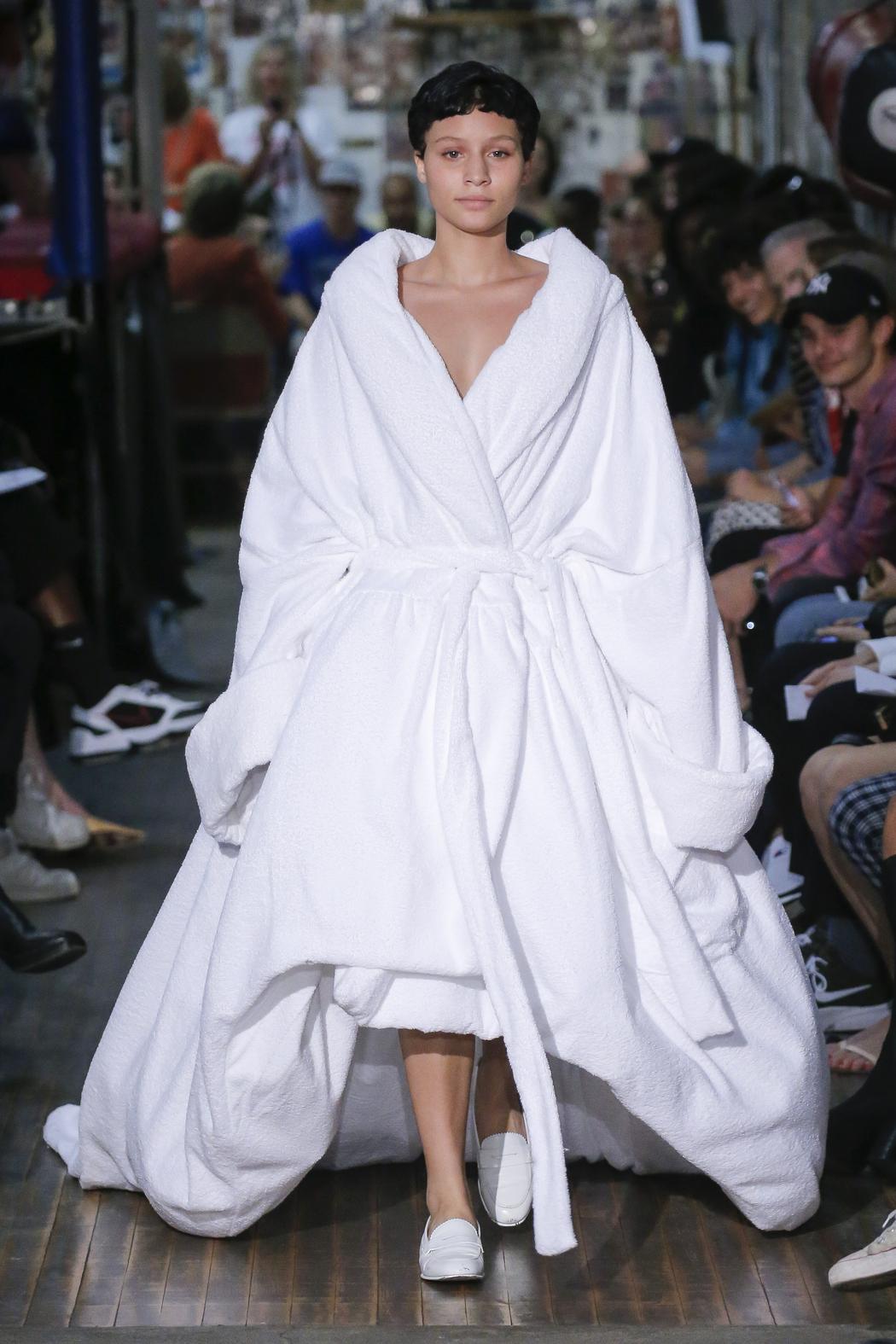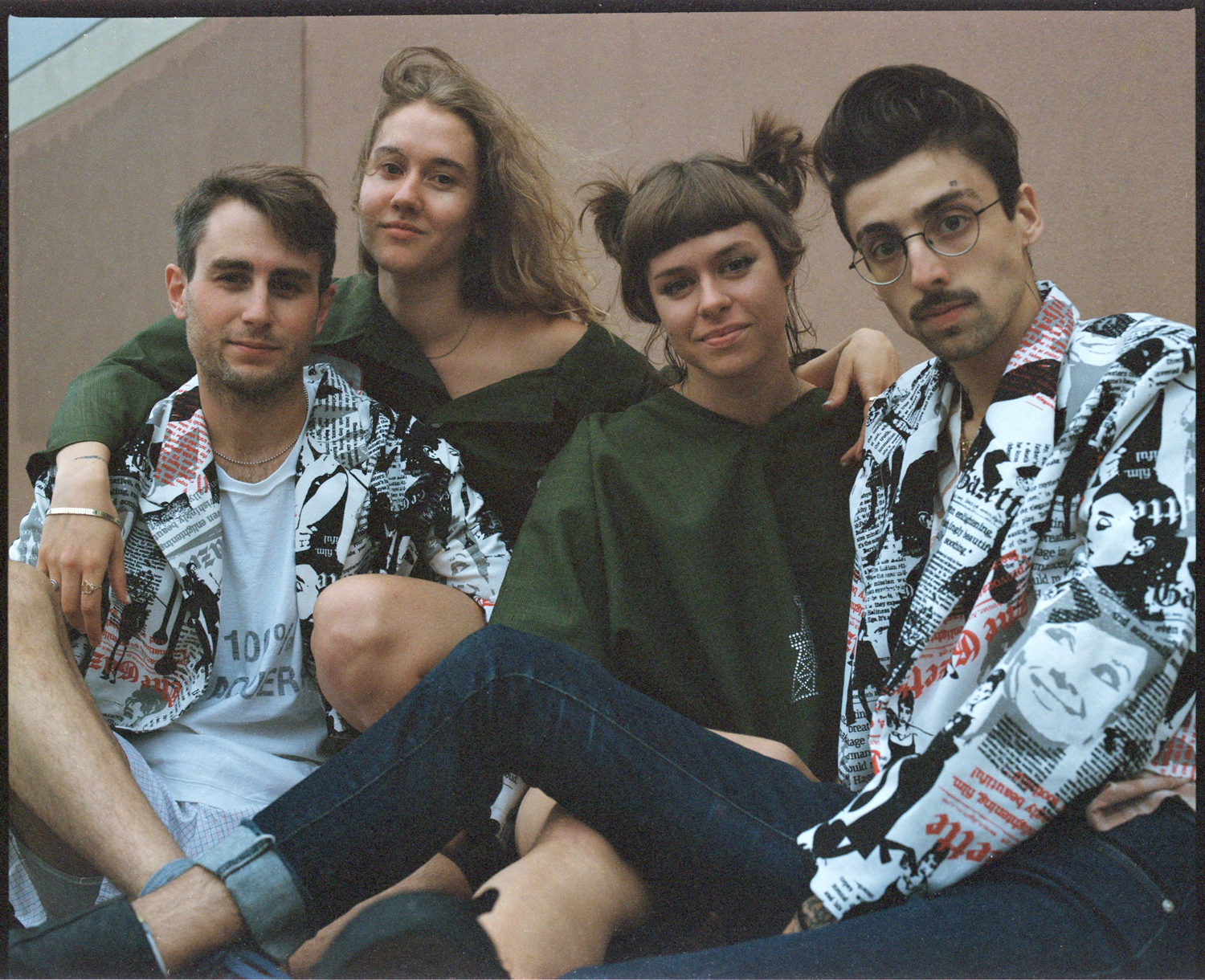On Tuesday, Vaquera debuted its spring collection in a downtown New York boxing club. Whoopi Goldberg, who sat in the front row, clapped with manic delight at the sight of a dress shaped like a giant gift-wrap bow. Afterwards, she said she would like to wear the finale piece, a terry-cloth ball gown slash bathrobe, if she ever hosted the Oscars again. “I didn’t know [Vaquera]. But I know them now and I’m going to find that dress, I’m telling you,” she said.
It wouldn’t be the brand’s first crossover into TV. In June, Vaquera presented a collaboration with Hulu: a runway collection inspired by the studio’s adaptation of The Handmaid’s Tale. The clothes, which ranged from a slip dress draped in bras to a hoodie with seven-foot-long sleeves, embodied much of what Vaquera has been about since its inception in 2013: playfulness, perversity, and a certain brand of punk DIY politics. The show raised the brand’s profile; in additional to the usual alternative fashion outlets, it was covered by the New York Times and even the New York Post.

This year, Vaquera is also a finalist for the CFDA/Vogue Fashion Fund. It’s an interesting choice given the prize’s commercial leanings and the fact that some of Vaquera’s most show-stopping looks have involved velvet jester pants, a giant chef hat, a bikini with a matching necktie, and a shredded T-shirt printed with the words “FUCK DEATH.” The brand has also presented its collections in Chinese restaurants and on subway platforms crowded with downtown artists, rather than at official NYFW show venues.
“In a way, it’s validation,” says Patric DiCaprio, one of Vaquera’s four designers, about the Fashion Fund, “It’s exciting to be nominated for something like this because it’s people like Anna Wintour who are interested in business saying that they’re interested in Vaquera. For a long time, we were really dismissed as ‘New York underground’ and ‘just an art project’ and ‘it will be over by next year.'”
The New York fashion industry has always had a reputation for valuing sales above innovation. But over the past few years, many of the city’s best-known brands have left to show in Europe and a new DIY energy has filled the void during fashion week. Vaquera, which has been leading this next generation along with the more established Eckhaus Latta, now has a new challenge: figuring out how to be a big small brand.

When I visit Vaquera’s Greenpoint studio just before fashion week, there’s a scrap of paper pinned to a cork board that reads, “WHO THE F*** IS VAQUERA?”
The board is tucked behind a striped sofa on which three of the designers — Patric, Bryn Taubensee, and David Moses — are sitting. Above them is a “Wall of Fame” displaying torn-out pages from magazine editorials and a picture frame filled with Lovables, small oddly shaped plush toys that they bought from a 50¢ vending machine at their bodega.
Claire Sully, the fourth designer, is seated on a chair to the side in an oversized (as in gargantuan) forest-green Vaquera workman’s shirt and silver Margiela Tabi shoes. Bryn’s diamanté Eiffel Tower shirt is made from the same fabric (and comes from the same collection). She’s also wearing boxer shorts, like Patric, who is sporting a newsprint-patterned jacket that matches David’s. They seem slightly indivisible, as if the answer to the question on the notice board might be that Vaquera is one person that just has many heads.
“We all design and we all do everything,” says Bryn. “People seem to have trouble believing that, but it’s really pretty evenly divided.”
“To the point where I would never consider something that I originally conceptualized as just mine,” David adds, “because I’ve had multiple conversations with everybody about it.”
“You can’t do an Exquisite Corpse all by yourself,” says Patric.
Vaquera designs collections like friends have conversations: the designers share thoughts and jokes, build on them, and create something far more complex and unexpected than its many parts. “We are all four, talking and talking and talking,” says Claire.
This season, for example, was a discussion about identity crisis. “Our identity crisis, but also I think everyone feels that way right now, because of the election,” Bryn explains. Each look is a character the designers developed in great detail (they even discussed imaginary relationships between them and who is dating who).
“We thought about punks and surfers, people who aspire to be something and feel the need to react to something,” says Claire. “And how subcultures cross over and mix,” adds Patric. It was also an attempt to figure out who the Vaquera boy or girl is. “And we’re beginning to narrow that down,” says Patric. The Vaquera protagonist, he explains, is someone who wears jeans and a T-shirt to the club and a ball gown to the post office. “Punk isn’t necessarily about how you dress. Or, it’s not about that stereotype of how punks dress,” adds Claire. “Wearing a crazy-ass hat and ball gown to the grocery store is punk.”

“I think it’s sad that people dress in such a dull way,” says Bryn. “It’s my fantasy to see everyone dressing in Vaquera-like clothing that’s really expressive and playful.” She says that while the brand used to be more “into bizarre clothing that kind of repulses people,” now they want to see their pieces in stores and walking down the street.
The mentoring the CFDA/Vogue Fashion Fund offers should help. “Another fantasy we have, that we’d love the CFDA’s support with, is creating other products that we couldn’t create now because we don’t have the skills or the funds,” says Patric. He references brands like Marc Jacobs and Comme des Garçons that subsidize their experimental runway collections with fragrances and leather goods sales. Vaquera is interested in making a perfume. “Could we create the next Angel by Thierry Mugler, the best-selling fragrance of all time?” he wonders.
But the most Vaquera thing Vaquera could do next is something totally unexpected. “Whatever it is going to be, we don’t even know yet,” says Claire. The designers are also conscious of not losing their vision by getting too big too fast. If future collections didn’t include clothes that felt at least slightly repulsive, what would Vaquera be? As Miuccia Prada said, “Ugly is attractive, ugly is exciting. Maybe because it is newer.”
Patric references a 1993 House of Style episode in which an interviewer asks Andre Walker what his collection is about. “And he’s like, ‘These clothes are for the corny girl, they’re for the stale girl that wants to be gross.” he intones. “He’s like, ‘I had to be as gross as I could this season because next season is going to be even grosser!’ I think what he’s talking about is that that’s how you create new styles and foresee the future.”
When Vaquera showed Renaissance-inspired styles for spring/summer 16 they felt jarring. Now, as Patric points out, Zara is filled with similar off-the-shoulder tops. In other words, commercial viability is often just a question of timing. Perhaps Vaquera doesn’t need to change; perhaps people just need to catch up.
“We’re making the world that we want to see,” says Bryn. A statement that feels especially powerful in 2017, when America, too, seems to be having an identity crisis.
